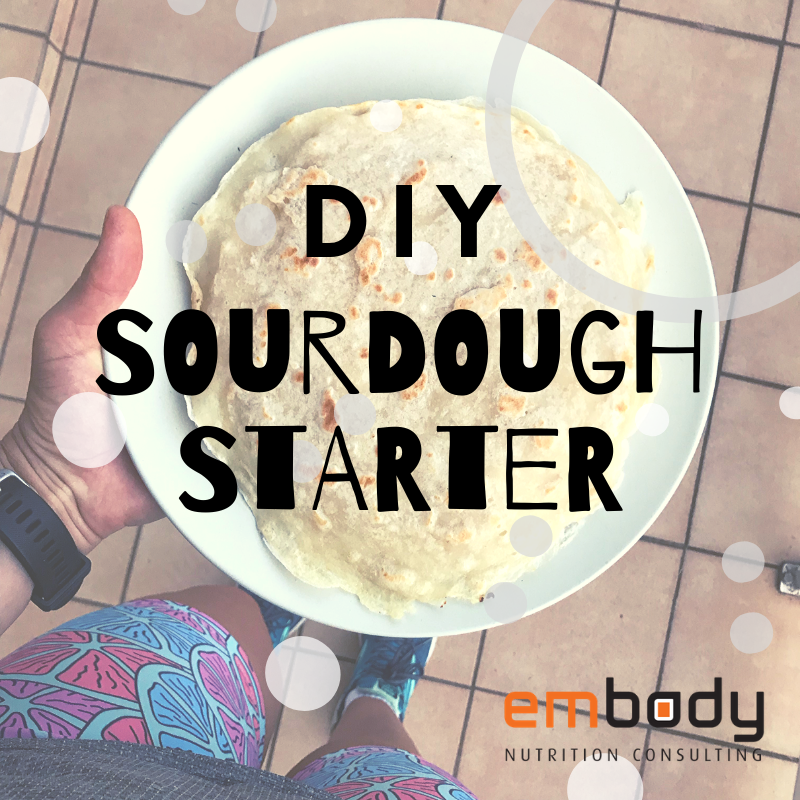I was unfortunately not lucky enough to have a sourdough starter passed down to me from a bread-making grandparent. But, I recently learnt how easy it is to make your very own sourdough starter – a fact that really surprised me!
The best part of all is that it requires no fancy ingredients – just flour and water. Before I get into the nitty and gritty of how to do it – I’m going to explain what a sourdough starter is, and why you should adopt one as your newest member of the family.
What is a sourdough starter?
If you’re interested in gut health, you might already know that there are trillions of bacteria, yeast, and fungi that live in your gut. You might not have considered that there are also microbes everywhere else – on our skin, in the air, on every surface, and luckily for us sourdough-loving people – in flour! Pretty crazy right?
Making a sourdough starter is how we cultivate the wild microbes that live in the flour into a form that we can use to cook and bake. We do this by combining flour and water and letting it sit – this is known as ‘wild fermentation.’ After a day or two, bubbles form – which means the wild yeast is becoming active, growing and multiplying via addition of the water. We then feed it to keep it happy (more flour and water) – and once it becomes bubbly and frothy – it is ready!
Why do we love sourdough?
I love wholegrain cereal products in general – and wholegrain sourdough products only increase my love for these products! Grains and bread in particular are often considered ‘bad,’ ‘fattening’ and restricted from certain ‘diets’ – but wholegrains are a health food.
Wholegrains are high in dietary fibre – but also contain a range of nutrients and bioactive compounds. Intake of wholegrain foods is associated with numerous health benefits – including a healthy weight, improved blood sugar regulation, and reduced risk of diabetes, cardiovascular disease and certain cancers. What’s more – wholegrain products and the fibre and resistant starch they contain feed the good gut bacteria that live in your gut – to help them grow, and help you thrive.
Sure, you can get fibre and some resistant starch from fruit and veg, but it’s pretty hard to meet your needs if you’re excluding grains entirely.
So, why sourdough?
Sourdough might improve the nutritional properties of rye, oat and wheat products in a number of different ways. Sourdough fermentation can:
- Improve texture and palatability – particularly of gluten-free and high-fibre breads.
- Stabilise or increase the amount of bioactive compounds, vitamins and minerals – including phenolic compounds, potassium, phosphorus, magnesium and zinc.
- Lower the glycaemic index – meaning the food is more slowly digested and absorbed, and has less of an effect on your blood glucose levels.
The Recipe – DIY Sourdough Starter
With some inspiration taken from fellow gut-health dietitian Megan Rossi, we have provided how-to DIY sourdough your own starter instructions. You’ll find many different variations on the internet – and I’m sure there are many ways to do it.
To start – you need:
- ¼ C strong white bread flour* (+ 6 more ¼ C for the following 6 days)
- ¼ C water
- A clean jar
- A muslin cloth (I actually just used a Chux – seems to have worked)
- A rubber band
*I used a quality white everyday all-purpose flour – though I have seen recipes call for anything from strong bread makers flour to whole-wheat, rye or any other!
To do it:
Day 1:
1. Add the flour to the jar and mix in the water.
- Cover with the cloth and secure with a band.
- Leave at room temperature.
Day 2-7:
- In the morning – stir the mix and replace the cover.
- In the evening – remove all but 1 Tb mixture from the jar – and then mix in a new ¼ C flour and ¼ C water.
- Repeat until day 8.
Day 8:
- Get excited – you’re ready.
- In the morning – stir. Your starter should appear fluffy with bubbles throughout, and smell slightly sour like yeast. If not – feed it for a few more days.
Store it right – and keep it forever:
Store your starter in the fridge with an airtight lid (from day 8). As you use it – replace it with equal parts flour and water. Feed it at least 1 x week with a minimum of 1 Tb flour and 1 Tb water (you could do more if you like). When you feed it – mix it and leave it on the counter covered with the muslin for 1-2h before returning to the fridge, with the lid on.
It’s kind of like a pet that’ll live forever if you take care of it.
Google is loaded with ways to use your starter – from wraps to sourdough pizza bases! Let us know if you give it a try.

